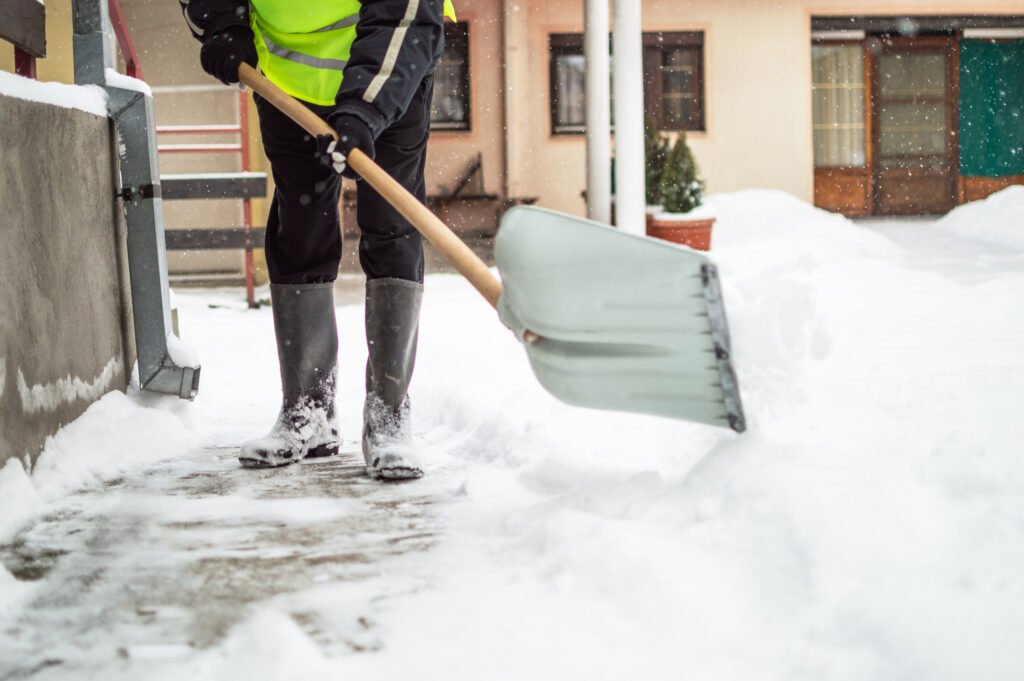
As winter descends upon us, the looming threat of snowstorms and unexpected cold spells has proven to be particularly disastrous for commercial properties across the United States. Massachusetts, New York, and Connecticut have been issued a ‘Snowmageddon’ warning this season.
This warning has emphasized the urgent need for property owners to take proactive measures in safeguarding your assets against the potential damages caused by snow and ice. These may range from leaky roofs to seepage in the basement, cracks in the concrete, or even collapsed structures due to the stress and strain of temperature changes and accumulating snow.
In this article, we will guide you through some essential steps to help ensure your property is adequately prepared for the challenges that winter may bring.
Assessing Roof Load Capacity: Can Your Roof Handle the Snow this Winter?
Snow-laden roofs, frozen gutters, and icicles are not merely picturesque winter scenes; they can signify potential threats to the stability of your commercial property. The critical factor in determining your roof’s ability to withstand the weight of snow lies in understanding the synergy between roofing material, size, and construction.
Today, most roofs are designed to bear the load of approximately twenty pounds of snow per square foot, providing a robust defense against typical winter conditions. However, the story changes for older structures burdened with weather-beaten materials and suboptimal construction. In light of the recent weather pattern shifts, this is a very significant issue commercial property owners must face.
Structural vulnerabilities, such as weakened supports and compromised materials, can significantly reduce a roof’s load capacity. This becomes particularly precarious when faced with the variability in snow types and accumulation rates.
As winter progresses, the weight of snow on your roof can increase, and prolonged exposure may lead to a gradual weakening of its structural integrity. It is imperative, therefore, for property owners to be proactive in assessing their roofs’ load-bearing capabilities, especially for aging structures.
Regular inspections, perhaps facilitated by experienced professionals, can identify potential weak points and guide you in adopting preventive measures to avoid winter-induced disasters.
Roof Inspection: Key Questions to Ask Yourself
Before the winter snowstorms arrive, a thorough roof inspection is a crucial step in fortifying your commercial property against potential damage. As you assess the condition of your roof, consider the following questions:
- Is Your Roof Structure Design Safe?
- Smooth roofs with steep slopes are optimal for snowy weather, enabling snow to easily slide off. For those with flat or pitched designs, it’s imperative to establish and adhere to a rigorous snow removal schedule to prevent excessive accumulation.
- Is Your Roofing Material Durable?
- Consider the resilience of your roofing material. Asphalt or slate shingles are recommended for their durability, outlasting the impact of snowfall more effectively compared to wooden roofs. Assessing the condition of your current roofing material can guide decisions on repairs or replacements.
- How Much Snow Can Your Roof Support?
- The load capacity of your roof depends on various factors, including snow type and accumulation duration. Regularly clearing your roof can mitigate the risk of exceeding its capacity. Understanding the specific load-bearing capabilities of your roof ensures a proactive approach to winter maintenance.
- What is the Age and Condition of Your Roof?
- Older roofs may exhibit signs of wear and tear, compromising their ability to withstand heavy snow loads. Assessing the age and condition of your roof provides valuable insights into potential vulnerabilities and informs decisions on maintenance or upgrades.
- Are There Signs of Wear and Tear?
- Inspect your roof for visible signs of wear and tear, such as cracked or curled shingles, deteriorating flashing, or weakened structural components. Identifying these issues early allows for timely repairs and helps prevent more extensive damage during winter.
- Do You Have Proper Insulation and Ventilation?
- Adequate insulation and ventilation play a crucial role in preventing ice dams and maintaining a consistent roof temperature. Verify that your property has proper insulation and ventilation to minimize the risk of snow and ice-related issues.
- Have You Checked for Water Leaks?
- Water leaks can compromise the integrity of your roof, especially during the freeze-thaw cycles of winter. Inspect ceilings and walls for any signs of water damage, as addressing leaks promptly is essential in preventing further deterioration.
Asking these questions during your roof inspection can help ensure a thorough evaluation, allowing you the opportunity to address potential vulnerabilities and fortify your property against the challenges of winter weather.
Potential Dangers & Risks of Snow & Ice Damage To Commercial Properties
As winter blankets our surroundings with snow and ice, commercial property owners must be vigilant against a myriad of potential dangers that can compromise the integrity of their establishments and increase both property and general liability risks.
Ignoring the impact of snow and ice can lead to severe consequences, both structurally and legally. Here’s a list of some potential dangers and risks that you may end up having to face as a result:
- Structural Damage:
- Accumulated snow on roofs can exceed load capacities, leading to structural damage or even collapse.
- The weight of snow, especially when mixed with ice, poses a significant threat to the stability of roofs and other structural components.
- Ice Dams:
- Poor insulation and ventilation can contribute to the formation of ice dams, where melting snow refreezes at the roof’s edge.
- This can result in water seepage under shingles, causing interior water damage and compromising the building’s structural integrity.
- It may also lead to black ice formation on parking lots and walkways, effectively increasing liability on your part.
- Frozen Gutters and Downspouts:
- Ice accumulation in gutters and downspouts prevents proper drainage, leading to water backups and potential water damage to the building’s exterior.
- Water pipes can also freeze during the winter, exploding as the water turns into ice and expands.
- This can result in costly repairs and impact the overall aesthetics of the property.
- Icicle Formation:
- Icicles hanging from eaves and edges pose a dual threat.
- Not only can they fall and cause injury, but their weight can also contribute to roof and gutter damage. There have been many cases where falling icicles have proven to be fatal for unsuspecting individuals!
- Regular snow and ice removal can mitigate this risk.
- Increased Liability: Slip and Fall Cases:
- Snow and ice-covered walkways and parking lots create hazardous conditions for pedestrians.
- Failure to promptly clear and salt these areas can lead to slip and fall accidents.
- This ends up increasing the risk of legal liabilities and potential lawsuits against the property owner.
- Make sure you plow your walkways and driveways regularly to help avoid liability.
- Roof Leaks and Water Infiltration:
- Melting snow, combined with ice dams and frozen gutters, can lead to roof leaks and water infiltration.
- This not only damages interior spaces but also compromises electrical systems, posing additional safety risks.
- It may also lead to mold on your property, which can be a significant health hazard for occupants.
- Exterior Surface Damage:
- Continuous freezing and thawing cycles can cause exterior surfaces, such as sidewalks and parking lots, to deteriorate.
- The expansion and contraction of ice can lead to cracks and potholes, posing tripping hazards and potential damage to vehicles.
- HVAC System Strain:
- The accumulation of snow and ice around HVAC units can impede their functionality.
- This places additional strain on heating systems, potentially causing breakdowns and costly repairs.
- Furthermore, poor insulation and ventilation, coupled with the strain on HVAC systems, can lead to increased energy costs.
- Solar panels on your commercial properties may prove inefficient as well if snow and ice accumulates.
- Failure to inspect insulation properly may lead to heating systems struggling, resulting in higher utility bills.
Neglecting to address snow and ice-related dangers can have far-reaching consequences for commercial property owners. Mitigating liability risks through diligent winter maintenance practices can help protect you from legal challenges associated with slip and fall cases and a range of other damage-related claims, too.
Final Words
In conclusion, preparing your property for snow and ice is a crucial step in ensuring the safety and longevity of your commercial space. Taking the time to assess your roof’s load capacity, inspect for potential issues, and seek professional assistance when needed can make a significant difference in preventing costly damages and premiums.
Remember, early proactive measures can save you from potential disasters in the winter months. On the journey to safeguard your property, partner with Acadia Insurance, your trusted ally in commercial insurance.
Our team is dedicated to helping you understand the challenges of winter and ensuring that your property is adequately protected. Contact us today for personalized insurance solutions that can be tailored to your unique needs. Don’t wait, secure your peace of mind with Acadia Insurance.
There for You: Acadia Insurance
At Acadia, we’re all about helping businesses throughout the Northeast thrive. Our mission is to provide superior service and product as close to you as possible, providing you with the coverage you need to proceed with confidence.
We understand what you want most from your insurance is security and peace of mind. That means knowing you are working with an insurance provider who will support you every step of the way to help you protect your business.
With Acadia, not only can you get coverage tailored to your needs, but you will also receive support from dedicated claims professionals to guide you through the claim process in the event of a loss. That way, you know exactly what to expect. Knowing your claims professional by name and a hand shake – that’s “Closer Coverage”. Get to know more about how we work and find an agent near you by going to the Find an Agent section on our public website (www.acadiainsurance.com).
Acadia is pleased to share this material for the benefit of its customers. Please note, however, that nothing herein should be construed as either legal advice or the provision of professional consulting services. This material is for informational purposes only, and while reasonable care has been utilized in compiling this information, no warranty or representation is made as to accuracy or completeness. Recipients of this material must utilize their own judgment in implementing sound risk management practices and procedures.



